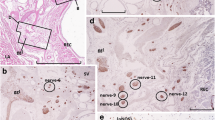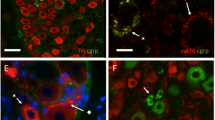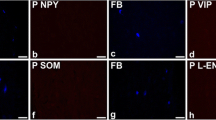Abstract.
To characterize further the injury response of autonomic ganglia, we have examined the effect of chronic denervation on perineuronal plexuses that are immunoreactive for vasoactive intestinal polypeptide (VIP) and tyrosine hydroxylase (TH) or that stain for nicotinamide adenine dinucleotide phosphate (NADPH) in the rat major pelvic ganglion, and their relationship to an identified sub-population of neurons in the ganglion (the penile neurons). Penile neurons contain VIP and NADPH diaphorase (NADPH-D) but lack TH. VIP-immunoreactive (VIP-IR) and TH-IR perineuronal plexuses (baskets) are rare in the rat major pelvic ganglion and those present are not associated with penile neurons. A small increase in VIP-IR baskets occurs 2 weeks after proximal interruption of the pelvic nerve, but TH-IR baskets increase five-fold. The emergent VIP-IR and TH-IR baskets enclose TH-negative neurons, none of which are penile ganglion cells. These changes remain up to 4 weeks after denervation. Interrupting the pelvic nerve nearer the margin of the major pelvic ganglion results in a rapid, more dramatic increase in VIP-IR, in cell bodies and beaded fibers, than that seen with the more proximal lesion. About 27% of neurons in the ventral pole of the ganglion are enveloped by NADPH-D perineuronal baskets. The incidence of NADPH-D baskets falls to less than 1% after acute interruption of the pelvic and hypogastric nerves, but their frequency returns to control levels in chronically denervated ganglia. The rapid, vigorous changes in peptide (VIP) fibers after the pelvic nerve is cut close to the major pelvic ganglion may be attributable to the interruption of axons of postganglionic neurons and to preganglionic nerve fibers, whereas the slowly developing changes in VIP-IR and TH-IR fibers after more proximal lesions may represent the more modest effects of true decentralization. The source and significance of the VIP-IR, TH-IR, and NADPH-D baskets that appear in chronically denervated ganglia remain unclear.
Similar content being viewed by others
Author information
Authors and Affiliations
Additional information
Received: 21 March 1995 / Accepted: 20 July 1996
Rights and permissions
About this article
Cite this article
Dail, W., Galindo, R., Leyba, L. et al. Denervation-induced changes in perineuronal plexuses in the major pelvic ganglion of the rat: immunohistochemistry for vasoactive intestinal polypeptide and tyrosine hydroxylase and histochemistry for NADPH-diaphorase. Cell Tissue Res 287, 315–324 (1997). https://doi.org/10.1007/s004410050756
Issue Date:
DOI: https://doi.org/10.1007/s004410050756




